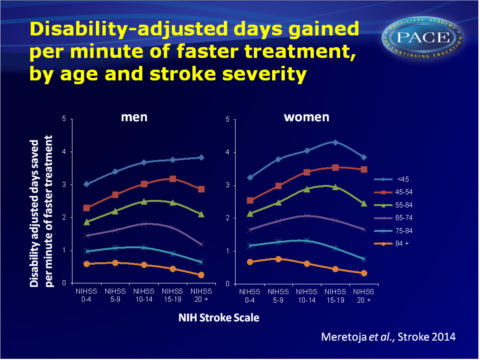Win a disability-free day with each minute earlier thrombolysis in stroke
Patients with acute ischaemic stroke gain at least a day of healthy life for each minute faster delivery of intravenous tPA for stroke thrombolysis.
Stroke Thrombolysis: Save a Minute, Save a DayLiterature - Meretoja A et al. Stroke. 2014 - Stroke. 2014 Mar 13
Meretoja A, Keshtkaran M, Saver JL, et al.
Stroke. 2014 Mar 13.
Background
Treatment of acute ischaemic stroke by means of intravenous thrombolysis with tissue-type plasminogen activator (tPA) is more effective when given early after symptom onset [1,2]. The odds ratio of tPA vs. placebo for disability-free outcome is 2.6 when treatment is started within 1.5 hours of symptom onset, and drops to 1.3 when started at 3 to 4.5 hours. Corresponding numbers needed to treat to achieve a disability-free 3-month outcome are 5 and 14 [2]. These numbers poorly communicate the overall patient health benefits of faster treatment.The best median door-to-needle times that have been described was as low as 20 minutes [3], but median in-hospital delays in American, Australian and European centers are 70 to 80 minutes [4-6]. Therefore a potential for accelerating initiation of treatment exists for most patients.
This study aimed to estimate the effect of speed in stroke thrombolysis on a patient’s lifetime, since quantification of long-term health benefits of faster treatment may promote practice change. Data of the Helsinki Stroke Thrombolysis Registry [3] and the Safe Implementation of Treatments in Stroke (SITS)-Australia [5] were used, amounting to 2258 patients.
Main results
- In the whole cohort, each minute saved provided a mean 1.8 days (IQR: 1.1-2.3 days) of disability-adjusted life-years (DALYs).
- The effect of faster treatment varied with age and National Institutes of Health Stroke Scale (NIHSS). In old patients with severe stroke, each minute saved provided on average 0.6 day, while in old patients with mild stroke 0.9 day was gained. In young patients with mild stroke on average 2.7 days were gained, and 3.5 days if strokes in young patients were severe.
- Women benefitted slightly more from faster treatment over their longer lifetime.
Download Meretoja stroke 2014 pace.pptx

Conclusion
A few minutes faster delivery of intravenous tPA for stroke thrombolysis already translates into significant benefits with regard to disability-free time over a patient’s life-time. Greatest gains from faster treatment were seen in the youngest patients and women who had the longest life expectancies after their stroke. Except for the oldest patients with most severe strokes, patients gain an equivalent of at least a day of healthy life for each minute saved.Thus, fine-tuning even the best of services is beneficial. Many strategies to reduce treatment delays have been published. These often simple and cheap organisation changes should be employed.
Find this article on Pubmed
References
1. Jauch EC, Saver JL, Adams HP Jr, et al; American Heart Association Stroke Council; Council on Cardiovascular Nursing; Council on Peripheral Vascular Disease; Council on Clinical Cardiology. Guidelines for the early management of patients with acute ischemic stroke: a guideline for healthcare professionals from the American Heart Association/American Stroke Association. Stroke. 2013;44:870–947.
2. Lees KR, Bluhmki E, von Kummer R, et al; ECASS, ATLANTIS, NINDS and EPITHET rt-PA Study Group. Time to treatment with intravenous alteplase and outcome in stroke: an updated pooled analysis of ECASS, ATLANTIS, NINDS, and EPITHET trials. Lancet. 2010;375:1695–1703.
3. Meretoja A, Strbian D, Mustanoja S, et al., Reducing in-hospital delay to 20 minutes in stroke thrombolysis. Neurology. 2012;79:306–313.
4. Fonarow GC, Smith EE, Saver JL, et al. Timeliness of tissue-type plasminogen activator
therapy in acute ischemic stroke: patient characteristics, hospital factors, and outcomes associated with door-to-needle times within 60 minutes. Circulation. 2011;123:750–758.
5. Simpson MA, Dewey HM, Churilov L, et al. Thrombolysis for acute stroke in Australia: outcomes from the Safe Implementation of Thrombolysis in Stroke registry (2002-2008). Med J Aust. 2010;193:439–443.
6. Mikulík R, Kadlecová P, Czlonkowska A, et al; Safe Implementation of Treatments in Stroke-East Registry (SITS-EAST) Investigators. Factors influencing in-hospital delay in treatment with intravenous thrombolysis. Stroke. 2012;43:1578–1583.
